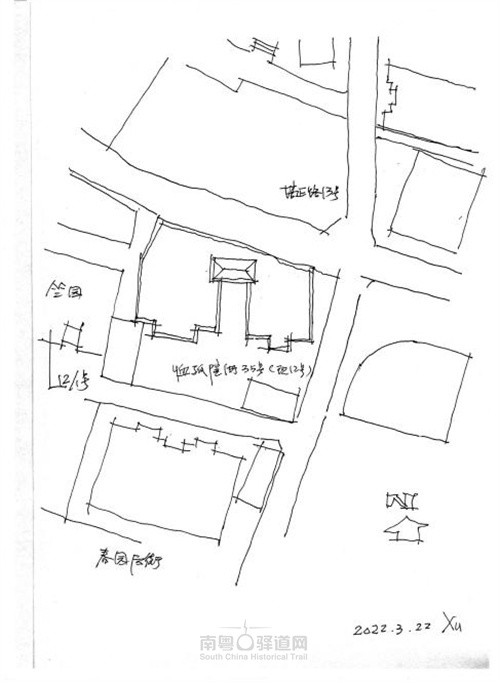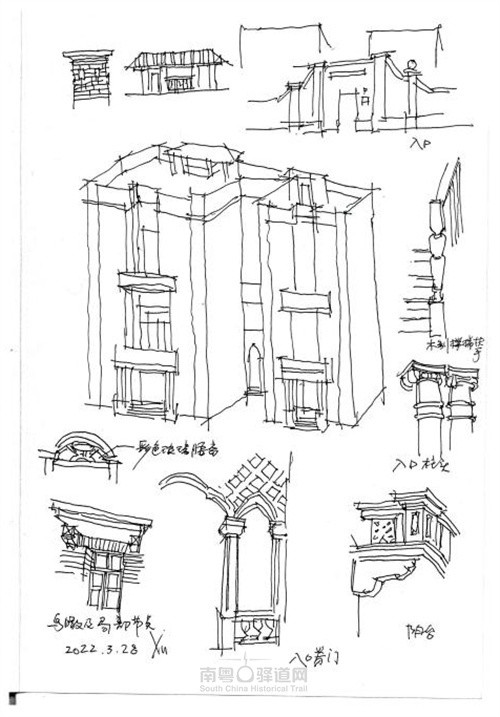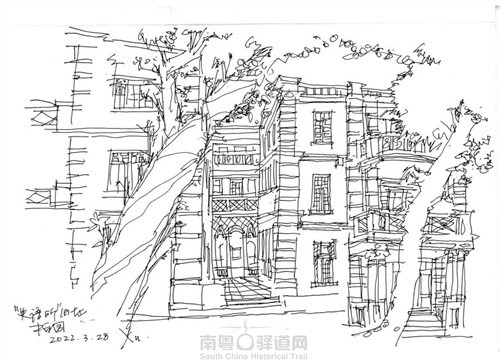Section II: The first academic journal of the Institute of History and Philology born in Dongshan, Guangzhou
Fu Si-nian mentioned the significance of the Institute History and Philology established in Guangzhou, has considered efforts to dialect and human folklore as a key area of investigation, a year or two moved to Nanjing, Guangzhou as a workstation. The biggest contribution and milestone after the independent establishment of the Park Garden in Guangzhou period was the publication of the first first subset of the 《Collected Papers 》.
In August 1928, Cai Yuanpei wrote the launch address for the Collected Works of the Institute of History and Language, and in May 1928, Fu Si-nian wrote "The Interest of the Work of the Institute of History and Philology". In the inaugural issue of the Institute of Historical Languages, published in October 1927, Hu Shih, Dong Zubin, Yu Yongliang, Shang Chengjo, Ding Shan, and Rong Zhaozu were among those who wrote articles. The front cover of the journal was printed with the manager of the Commercial Press of various places for distribution, and the back cover was printed with the address of the Institute, BaiYuan, Dongshan, Guangzhou, and the statement that "it is a temporary address that may have to be moved to Beijing or Beiping later. The weekly newspaper of Guangdong National University, which had just been published at that time, introduced the magazine in the book and newspaper section, describing it as "a touchstone for them, a field for them to mow the grass!"
In the "Collected Papers" (1928, the first book of the first division), Dong Zuobin published an article on the "Trekking Tang writing book cut rhyme scraps----跋唐写本切韵残卷", Yu Yongliang published "Yi Gua lines of the times and their authors----易卦爻辞的时代及其作者", Yung Zhaozu published " divination source----占卜源流", Shang Chengjo published "said 'Zhu----朱'", and accompanied by the service records. Except for Mr. Hu Shih, all the other professors of National Sun Yat-sen University, Dong Zuobin's article was an old work, and Shang Chengjo continued to exert his profound knowledge of Chinese writing, explaining the character "Zhu----朱" from seal script, Jinwen and oracle bone script, and on March 11, 1928, Shang Chengjo finished writing "Explaining Wu On March 11, 1928, Shang Chengjo finished writing "Explaining Wu", which was published in the 20th issue of the Weekly, in response to a question from Yung Shiu-tsu about the word "Wu----武". [7].
The Collected Papers (the first book, the second division) was published in Beiping, but much of the research work continued as originally planned. The second part published Fu's article "The Chinese Book Style of Warring States Literature", written in February 1929, when the Institute of Historical Studies was still in Guangzhou. The third part was published in 1930 in Beiping, with linguistics as its theme, and the article published by Luo Changpei was "Postscript to the Remnants of the Collection of Sound and Rhyme Tongran", which is of great historical value, with the following inscription: "In the eighteenth year of the Republic of China, April 24, Luo Changpei wrote in Guangzhou, Dongshan, BaiYuan ". It can be said that in 1929, linguistic research continued to be carried out in the BaiYuan.
Section Ⅲ: The Spatial Environment of Dongshan in the 1920s
I am not in love with Guangzhou, frankly speaking, because tn a letter to his classmates at SUN YAT-SEN UNIVERSITY on October 13, 1930, Gu Jiegang wrote, "I here are not enough reference books, there are no academic groups, and the buildings are small, so that I cannot move all my books ......" [8]. emotional language, a few years ago Yu Dafu wrote in his diary on the third day of November 1926: "Today is Wednesday, to Guangzhou is the Friday before the previous week, after setting foot in Guangzhou, and is 12 or 13 days, I really regret coming here this time, really regret coming to this Baiyue barbaric land." [9] It is impossible to guess their love and hate. To be fair, Guangzhou city was quite lovely in the 1920s and 1930s, especially Dongshan.
The "Complete Map of the Fourth Phase of Roads in Guangzhou" was prepared in 1927, and began the implementation of road improvements to the Xiguan area, beginning the plan to emphasize east-west extension as the main thoroughfare. The road development in Xiguan area was resisted by the failure to get the understanding and support of the citizens, and the gentry and the municipal authorities were always in a state of conflict and stalemate. During Sun Ke's term of office, he broke "this feudal closed-door policy and opened up six streets in Xiguan (Jing Yuan, Tong Xing, Tong Wen, De Xing, Yong An, Lai Yang), while Sha Ji Road was the second. The municipal authorities were very anxious about the limitations of the citizens' perceptions. The original Xiguan road plan, "the first and second phase of the last plan, and the people of Xiguan to no official above the supervision, Yi sound playful self-pleasure, do not want to change the course, the old-fashioned people are still in the current near-term benefits, but forget the hundred-year plan. [10] This road plan in addition to the progress of Xiguan, Dongshan proposed to form a group of road framework, the design of the road network of Dasha Island included in the plan. Yuexiu Mountain and the urban area is intended to strengthen the relationship with the urban area through road construction. The road system pays attention to the urban area while focusing on the connection of the outer suburbs. The residential function of Dongshan gradually appears.
The then mayor of Guangzhou was Lin Yunxin (1883-1948), a native of Xinyi, Guangdong. His senior ancestor, Lin Tingxie, was a governor of Yiyang and Hengyang in Hunan Province, and received a private education at an early age, and entered the Haisan Academy in Gaozhou Province to study scripture, history, words and chapters.
Lin Yunxin served as the mayor of Guangzhou (including the chairman of the municipal committee) three times, from 1923.2.8 to 1923.2.26, 1927.5 to 1927.11 and 1928.1 to 1931.6, for a total of about four years. The first two terms of office were very short, and the third term was quite remarkable in terms of political achievements. Later, Lin Yunxin served as the chairman of the Guangdong Provincial Government Committee for five years (1931.6-1936.7). Later, he went to Nanjing to serve as the Minister of Audit until his death. He was the most experienced mayor in Guangdong and knew Guangzhou best.
The most important period of Lin Yunxin's tenure as mayor of Guangzhou was from 1927 to 1931, when, as he said in his self-evaluation, "since he took office, he has been working intensively for the proper facilities of the city, both material and spiritual, in order to be effective. [11] At the beginning of his appointment, he was full of expectations for the construction of the city, but two years later, looking back on his urban construction practice, he had a lot of feelings: "But according to the experience of the past two years, things often went wrong as expected. The construction of various kinds of construction, because of the lack of financial resources and can not lift some, because the public does not understand and stalled in the middle of some of them." [12]
In engineering practice, Lin Yunxin first promoted the renovation of the city's road system, and his outstanding contribution was shown in his third term, during which new roads were built in two years, including Sugi Bar, Thirteen Houses, Eighteen Foo, and Changshou Street. According to the financial resources of the City Hall, the roads were built according to their capacity, both asphalted and gravel roads. Secondly, it continued to clear the Six Veins Canal, and then the construction of a series of public buildings and activity places, notably Baiyunshan Park and Yuexiu Mountain Foothills Public Sports Ground were the construction achievements of this period.
During his term of office, he paid more attention to the development of public utilities, restoring the Public Utilities Bureau in August 1927 and reforming a series of public utilities such as waterworks, operating cars and telephones, establishing the Waterworks Management Committee in 1929, the Municipal Utilities Manager's Office in 1928 and the Automatic Telephone Committee in 1929 to strengthen management and coordination, which not only improved the quality of life of citizens but also saved the government's administrative This not only improved the quality of life of the citizens, but also saved the government's administrative expenses.
Gu Jiegang often recorded in his diary that he walked from the small east gate to the school. Analyzing his path, on the east side of Dongshan, the Little East Gate is where the circular-shaped city wall was dismantled and joined with Huaiai Road on the east side, and the site of Sun Yat-sen University is at the southeast corner of the circular road, close to the original city wall, which was built after the wall was dismantled. The road is being improved in the area of Dongshan Xinhepu, and the area where the professors live in Dasha Island and Dongshan Xinhepu is a water area.
Yu Dafu's diary records on November 19, 1926: "The school met and stayed open until six o'clock in the afternoon, took a bus to Dongshan, they were all gone, and one ate the evening meal at Dongshan Restaurant and went back to bed." Yu Dafu was scheduled to go to Dongshan with Bai Wei to find Wang Duching. They were both members of the Creation Society. In Gu Jie's diary or Yu Dafu's diary, it is recorded that the main restaurants where they gathered for dinner were Dongshan Restaurant, Dongfang Restaurant, Nan Yuan, Ju Feng Yuan, and Wuling Restaurant.
The "Plan of Administration of the Guangzhou Municipal Government" made in 1929 was the most complete plan of the government in the early days, and it strongly promoted the development of a model residential area in the Zhusigang area of Dongshan, which led to the establishment of a modern residential model in Guangzhou. In view of the current situation of high density in the old city and in order to solve the housing problem of the middle class, the 108th Executive Council in 1927 proposed a plan to build a model residential area in the city, and the three bureaus of land, public service and finance were in charge of the plan and set up the constitution. At that time, the European concept of "idyllic cities" was very fashionable. In Sun Yat-sen's "Industrial Plan", he specifically talked about how to realize the construction of Guangzhou City according to this idea, "If we build a garden city with a pleasant forest, it can be considered an ideal location." [13]
The model residence at Zhusigang in Dongshan was the experimental site for the new municipality. At that time, the Bureau of Public Works proposed in the "Implementation Plan of Guangzhou Public Works" that "the eastern suburbs have a lot of open space, and there are quite a lot of fields and forests and springs, so using it as a residential area is most suitable for health. And can make people enchanted in the natural sense of beauty, its benefits to the public body and mind will be very shallow." "Check the improvement of residential matters, since the end of the European War, the city governments of various countries pay more attention to this, when the British have said that the city of the field, can be a model for new-style housing, countries are competing to follow ......" [14] Dongshan natural environment is excellent relative to the Xiguan area. In 1928, the "Guangzhou Model Residential Area Committee" was set up and the "Regulations for the Preparation of the Model Residential Area of Guangzhou" was published and implemented, and a number of technical specifications for land ownership, roads and housing were formulated with modern construction concepts. The planning and design of road forms, greenery and drainage methods were fully based on modern cities in Europe and America. Thanks to the leadership and implementation of the municipal government, the Dongshan model residential area has basically achieved the physical construction goal of creating a clean and beautiful urban living environment, attracting a large number of government officials and overseas Chinese who have returned to China to invest.
Guangzhou is aiming at creating a new Guangzhou in the style of "city and mountains" by expanding the urban area, developing the suburbs, and operating model residential villages, and "putting the city in the countryside". "The goal was to expand the urban area, develop the suburbs, and operate model residential villages. [15] However, it should be noted that Guangzhou's practice is different from the "urban-rural magnet" social and urban spatial model proposed by Howard in 1902, which combines the advantages of rural and urban areas, establishes "land development commons", and maintains a balance of employment, housing, shopping, education, and recreation. It fails to truly understand the essence of Howard's idea of achieving social improvement through urban transformation, and is more a reflection of Howard's advocacy of restoring "the quiet and healthy environment and closeness to nature that had disappeared from the inner city in the 19th century. [16].
The buildings on both sides of Dongshan Xinhepu are from the early 1900s, and a network of streets has taken shape in and around XuGu Road, Gueigang South (present-day Gueigang Dam Road). On the east side of XuGu Yuan Road was the orphanage (Xu Gu Yuan), and at the north end was Pei Cheng Girls' School and Pei Dao Girls' School. On the opposite side of Pui To Girls' School was Pui Ching Boys' School; at the northern end of Kui Kong South was the post office and Baptist Hospital, and further north across Temple Street, on the east side was the police station and Tung Shan Park. [17] Gu Jiegang's diary often mentions Dongshan Park. It is inferred that BaiYuan was completed in the early 1920s. According to the latest property files consulted by the Guangdong Institute of Cultural Relics and Archaeology, the earliest owners were Cai and his son. BaiYuan is surrounded by small three-story houses with red bricks as the exterior material, and most of the buildings are eclectic in style. Kuiyuan was built in 1922, and the owner was an American Chinese, Ma Zhuowen. [18] BaiYuan in the Guxu Yuan road, is named for the orphanage, was bombed by the Japanese army in 1938. In 1903, the Southern Baptist Hospital in the United States bought the land to build a school. This area is mostly owned by Chinese who bought the land to build their own property and named it with Chinese names, including Kui Yuan, Run Yuan, Shen Yuan, Ming Yuan, Chun Yuan, Jane Yuan, and Zhu Yuan, of which BaiYuan is one. BaiYuan has a mixture of various columns and Western classical architecture, and uses a traditional Chinese style roof with glazed tiles on the roof stairwell. The architecture of the Park makes the best use of the site and is irregular in plan. It is divided into East Block and West Block, with the East Block smaller than the West Block.

The picture shows the general plan of Dongshan BaiYuan and the surrounding environment road, drawn by the author.

The picture is a bird's eye view of BaiYuan and some of its characteristic nodes, drawn by the author.

The picture shows the current status of the landscape of Dongshan BaiYuan, sketched by the author.
(to be continued)
Notes:
[7] Shang Chengjo: The Collected Writings of Shang Chengjo, Guangzhou: Zhongshan University Press, 2004, 19 p.
[8] Gu Jiegang, The Collected Letters of Gu Jie-gang, vol. 2, 348 pp.
[9] Yu Dafu, Nine Kinds of Diaries, Zhengzhou: Zhongzhou Guji Publishing House, 2019, 2 pp.
[10] Editorial Unit of the General Affairs Section of the Guangzhou Municipal Government: Repertory of Guangzhou Municipal Reports, 1928, p. 5.
[11] Guangzhou Municipal Government, edited by: Guangzhou Municipal Government Statistical Yearbook, 1929, p. 445.
[12] Guangzhou Municipal Government, edited by the Guangzhou Municipal Government: Statistical Yearbook of the Guangzhou Municipal Government, 1929, p. 453.
[13] Sun Yat-sen: The Founding of the State, 1921.
[14] Guangzhou Municipal Government: Statistical Yearbook of Guangzhou Municipal Government, 1928, p. 3.
[15] "Two Plans in the Climax of Municipal Innovation Movement", Guangzhou Municipal Bulletin 1930.
[16] [U.S.] John M. Levy, Modern Urban Planning, China People's University Press, 2003, p. 46.
[17] Nan Yue Ancient Post Road Project Group: Returning to the historical time and space of Yang Lüan Martyr in Guangzhou, Guangzhou: Zhongshan University Press, 106 p.
[18] Nan Yue Ancient Post Road Project Group: Returning to the Historical Space and Time of Yang Lagenda's Martyrs in Guangzhou, Guangzhou: Zhongshan University Press, 165 p.
(All rights reserved. Please indicate that it is from South China Historical Trail Network.)
责任编辑:何洛曦